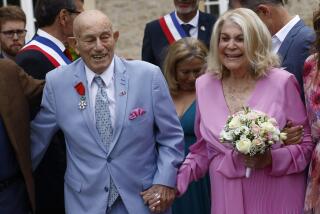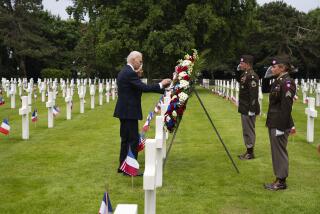Searing D-day Memories Bind Aging Veterans for a Lifetime
- Share via
RANDALLSTOWN, Md. — A few months ago, 83-year-old William Walsh made a 100-mile round trip from his home in suburban Baltimore to Arlington National Cemetery in Virginia for the funeral of a man he didn’t know.
To Walsh, it didn’t matter that he had never met the retired captain buried that day. Both had been part of the Army Ranger 2nd Battalion assault on the cliffs near Omaha Beach on D-day. That was enough.
“The fact that he was in the Ranger battalion was all I needed,” he said in the den of his home in Randallstown, standing near a fading black-and-white framed photo of his company lined up during training.
In the 60 years since they took part in the massive invasion of Normandy, D-day veterans have raised families, taken on careers and eased into long retirements. Almost all are well into their 80s.
But the memories of June 6, 1944, remain vivid -- memories of rushing off landing craft under withering fire, plunging from airplanes at night to parachute behind German lines, seeing friends die next to them.
To many, their role in a monumental moment in American history is still a pivotal part of their lives.
“I guess it’s the most important thing I’ve done,” said Herman Stein, 83, who landed with Walsh and now lives in Fort Pierce, Fla. “I was lucky to get through it. If I die tomorrow, so what?”
In the largest amphibious landing ever, more than 150,000 American, British and Canadian soldiers landed at five beaches on June 6 or parachuted in the night before. An estimated 10,000 Americans and their allies were killed or wounded that day, according to the National D-day Memorial Foundation in Bedford, Va.
Douglas “Curly” Dickerson landed in Normandy along with a 40-member team of 82nd Airborne paratroopers at 9:30 the night before D-day. They hunted down a mobile radio unit, he recalls, stabbing the German soldiers to death. They then fought off counterattacks through the night.
A former quarterback at North Carolina State University, Dickerson was part of a team of commandos made up of ex-athletes. He was one of four from the team to survive parachute jumps into Italy, Normandy and later Holland.
Describing himself as still “chipper” at age 84, Dickerson has lectured for the last 20 years about his World War II experiences and ran a small museum out of his house in Greensboro, N.C. As the number of living D-day veterans dwindles, he believes, it is critical to preserve a record of their deeds.
“I think kids ought to know what we sacrificed,” he said.
As Dickerson and the paratroopers battled inland the morning of June 6, landing craft carrying soldiers of the 2nd Ranger Battalion bounced through the rough surf toward cliffs 100 feet tall at Pointe-du-Hoc overlooking the Omaha Beach landing site. Their mission was to scale the cliffs and take out heavy guns that supposedly sat on top.
Walsh remembers rushing out of the landing craft and setting up his mortar in a crater, firing off a series of rounds onto the German machine guns above. As he stood up to move on, a sharp blow to his head dropped him to the gravelly sand. A bullet had lodged in his neck, just centimeters from his spinal cord.
Meanwhile, Herman Stein and the rest of the Rangers climbed ropes and ladders to reach the top. They didn’t find the guns, but did run into heavy German fire. One man died from a bullet to the throat as Stein tried to plug the wound with his hand.
D-day was just the beginning of months of fighting for the Rangers. Walsh recovered from his bullet wound and rejoined the Rangers -- he and Stein later were among only a handful of men from their unit who survived brutal combat near Hurtgen Forest on the German-Belgian border.
Those months spent together, along with the shared experience of the horror of battles only they can recall, led to strong friendships among the Rangers. Many still talk on the phone and meet when they can for reunions. Stein was holding the hand of a fellow Ranger when the man died recently.
“I’m proud of being a Ranger. They are the best bunch of guys,” he said. “We were as close as we could be.”
On Omaha Beach, the first units of the 29th Infantry Division were landing under ruinous fire from German guns as the Rangers climbed the cliffs, losing hundreds of men before they could even wade to shore.
But while other companies of the 116th Regiment were pinned down, John Polyniak remembers his C Company encountering only light resistance as they came ashore farther down the beach. They made their way inland, meeting up with the Rangers who had found and destroyed the missing guns.
Eleven days after D-day, Polyniak was shot in the hip, a wound that would take months to heal. At 85, he still wears a brace on one leg and can’t move his toes.
He is proud to have fought with the 29th Infantry, especially after the division’s actions were featured in the movie “Saving Private Ryan.” But when he saw the film in the theater in 1998, the graphic combat depicted was too much of a reminder of what he had seen 60 years ago.
“The next day they had to take me to the hospital with chest pains,” said Polyniak, who lives in Brooklyn Park, Md. “It just affected me that much.”
Three days after D-day, Evelyn Kowalchuk landed in a C-47 on metal planks laid down on Omaha Beach. A nurse with the 818th Medical Air Evacuation Squadron, she was one of 25 women who flew near the front lines to pick up wounded troops and ferry them back to hospitals in England.
Over the next several months, Kowalchuk would fly as many as three flights a day into combat zones to pick up the wounded. She made close friends, and organizes regular reunions for the remaining members of the 818th. Two years ago, the French government awarded her the Legion of Honor.
But for years she rarely spoke of her experience, even to her husband and children. She didn’t want to seem as if she was bragging and she didn’t feel like dredging up gruesome memories. It was only when the director of the D-day Memorial persuaded her that her story had important historical value that she began speaking to schools and community groups.
“If you could say you saw a kid at 18 years old with both his legs off, you just couldn’t talk about it,” Kowalchuk, 84, said from her house in Huddleston, Va.
And although he is proud of his service on D-day and during the war, Dickerson says he is still haunted by memories of what he did and saw.
“I was sick of all of it by the end,” he said. “I’ve killed people. I’ve killed a lot of people. I’ve seen a lot of people get killed. It eats on me, always has and always will.”
More to Read
Sign up for Essential California
The most important California stories and recommendations in your inbox every morning.
You may occasionally receive promotional content from the Los Angeles Times.













